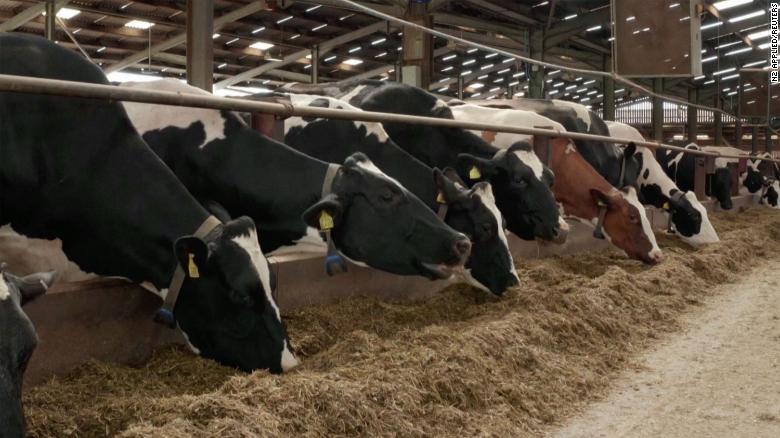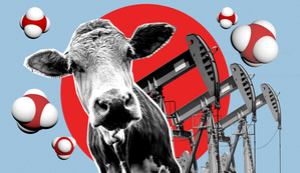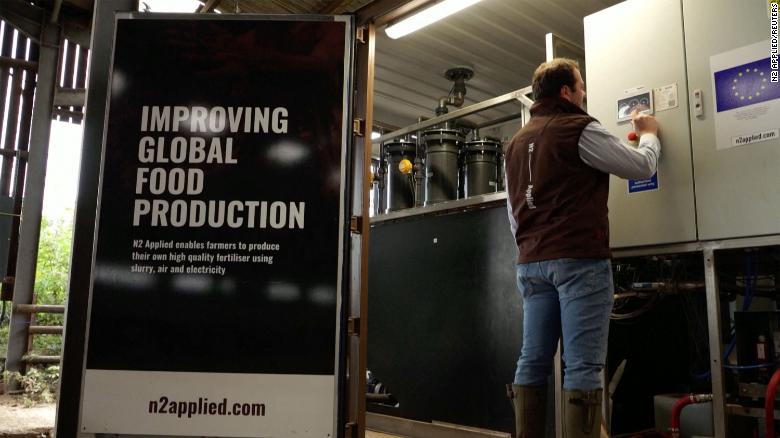Story by Reuters
Wed December 1, 2021

Dairy cows at a test farm in Buckinghamshire, England, where the Oslo-based company N2 Applied is testing plasma technology to prevent methane emissions.
A Norwegian technology company has found a way to stop livestock slurry from releasing methane -- by zapping it with artificial lightning.
Methane is a potent greenhouse gas emitted from sources including leaky fossil fuel infrastructure, landfill sites and livestock farming.
Oslo-based N2 Applied is testing its plasma technology at several sites in Europe, including on three farms in the UK.
"In essence, we're harnessing lightning to zap livestock slurry and lock in harmful emissions," N2's Chris Puttick told Reuters at one of the test farms in Buckinghamshire, England.
At this site, 200 dairy cows are providing the raw material: dung.
A manure scrapper collects all the excrement from the barn floor and deposits it in a pit where it is then moved through the N2 machine, housed in a standard-sized shipping container. Nitrogen from the air and a blast from a 50 kilowatt plasma torch is forced through the slurry 'locking in' both methane and ammonia emissions.

Scientists say this invisible gas could seal our fate on climate change
"When we add nitrogen from air to the slurry, it changes the environment to stop methanogenesis basically. So it drops the pH down to just below six and we're catching that early. So it stops the breakdown of those methane microbes that then release the gas to the air," Puttick said, adding their patented technology is the only one of its kind.
What comes out of the machine is an odorless brown liquid, called NEO -- a Nitrogen Enriched Organic fertilizer.
According to N2, their NEO has double the nitrogen content of regular nitrogen fertilizer; one of the most commonly used fertilizers to boost production of corn, canola and other crops.
Puttick said independent tests showed their technology reduces methane emissions from slurry by 99%. It also cuts by 95% the emission of ammonia; described by the EU as one of the main sources of health-damaging air pollution.
On a 200-cow dairy farm this equates to "a reduction of 199 tons of carbon equivalent every year with one machine," said Puttick, adding that they're now looking to scale out the technology across the UK livestock sector, and have recently installed it at a pig farm.

The N2 Applied farm in Buckinghamshire, England.
A commercial model of the device is due for release in June 2022, in a modular "stackable" form; so bigger farms can add units to cope with their amount of slurry. Exact pricing is yet to be announced, but Puttick said capital investment for a farm will be similar to that of a medium-sized tractor.
N2 Applied has received over 17 million euros (around US $19.2 million) of funding from the European Union's Horizon 2020 research and innovation program.
The Global Methane Pledge, launched at the COP26 summit in Glasgow in November, committed to reducing methane by 30% by 2030.
Methane has a higher heat-trapping potential than CO2 but it breaks down in the atmosphere faster, meaning deep cuts in methane emissions by 2030 could have a rapid impact on slowing global warming.
A UN report in May said steep cuts in methane emissions this decade could avoid nearly 0.3 degree Celsius of global warming by the 2040s.
No comments:
Post a Comment